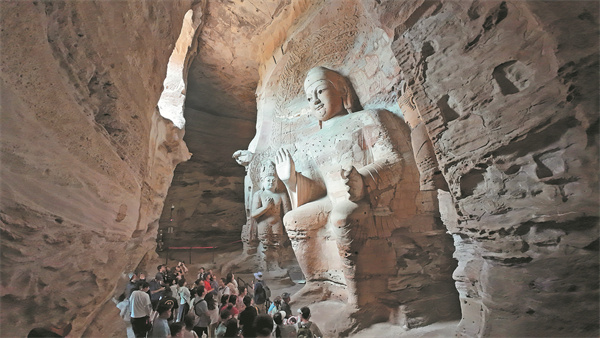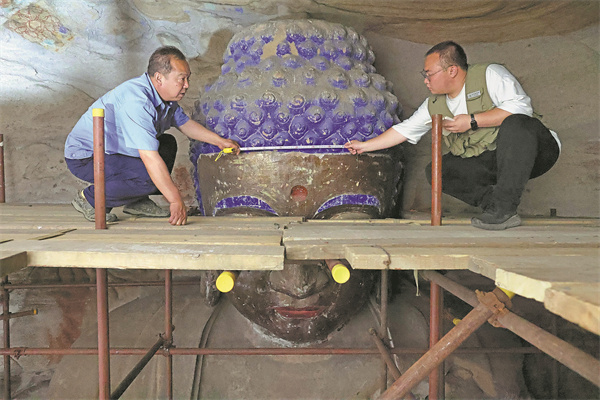Yungang Grottoes get tech boost


At 25 meters tall and 50 meters wide, the third cave of the Yungang Grottoes is the largest. The cave houses a sitting Buddhist statue that attracts tourists on July 14. [Photo provided by Zhu Xingxin/China Daily]
The Yungang Grottoes in Datong, Shanxi province, are a UNESCO World Cultural Heritage site. Existing for nearly 1,600 years, the caves are deemed "history engraved on stones" by Hang Kan, director of the Yungang Research Institute, formerly known as the Yungang Grottoes Research Institute.
"We must protect, study, present and pass the history down to future generations," Hang is quoted as telling Shanxi Daily. Hang says the team is enlarging the range of protection and delving into the details by applying more scientific methods and advanced technology.

Zhao Bin (left), also with the institute, maps a Buddhist sculpture's head with his colleague in the ninth cave. [Photo provided by Zhu Xingxin/China Daily]
In 45 of the major caves of Yungang, the 254 extant grottoes host more than 59,000 sculptures from the fifth century.
Zhao Bin, with the institute, has been working on the restoration of the Buddhist sculptures and statues for 12 years. On one recent July day, as on any other workday, Zhao was spotted on scaffolding in the ninth cave.
"I always feel in awe of the history and thus work with great passion and a sense of responsibility," Zhao says, adding that is what has supported his tedious efforts day after day.

On the same day, the scanned images of the grottoes offers a glimpse of the digital archive. [Photo provided by Zhu Xingxin/China Daily]
Growing up in Datong, Zhao says he has witnessed the area's development, which has attracted more young talent to join in protection and restoration.
Dai Yuxiang, who has excelled in restoring murals for 11 years with the institute, feels the same and says his work is more like a doctor than a beautician.

A staff member at the institute's digital protection center examines a 3D-printed replica of head of a Buddhist sculpture on July 15. [Photo provided by Zhu Xingxin/China Daily]
"The Yungang murals are the epitome of traditional Chinese craftsmanship," Dai says. "I can always feel and touch the ancient artisans' devotion to the murals they created."
Besides manual labor, digital and information technologies are being used more in Yungang, such as digital scanning and 3D printing. These new technologies enable visitors to enjoy the grottoes with virtual reality glasses to explore the historical site in boundless time and space.

Dai Yuxiang (right), a mural expert with the Yungang Grottoes Research Institute, works on restoring a mural at the institute on July 15. [Photo provided by Zhu Xingxin/China Daily]
Shanxi province highlights the preservation of the Yungang Grottoes and the construction of Yungang Studies. A 14th Five-Year (2021-25) Plan for the Protection of Cultural Relics of the Yungang Grottoes was developed. The digital documentation has already covered two-thirds of the total relics, with completion planned by 2030.
The institute has been establishing the digital archive via the Digital Yungang Information Center.
Universities in Shanxi have also established institutions for Yungang Studies, as well as Yungang cultural ecology research centers. The Yungang institute joined hands with Peking University and others to conduct foundational research for Yungang Studies. To delve further into the historical connotation and significance of interactions and exchanges among various ethnic groups that the Yungang Grottoes embody, the joint work will expand Yungang Studies and their cultural influence internationally.

Feng Jun (left) and his colleague Jia Ning meticulously repair a mural at the institute on July 15. [Photo provided by Zhu Xingxin/China Daily]
Byzantine-styled copper goblets have been unearthed in the caves, and there have also been traces of Greek columns and Persian instruments.
"The Yungang Grottoes are a result of cultural exchanges between China and the rest of the world. When researching a multicultural hub like this, cross-disciplinary study is a consistent principle," says Sun Yu, professor of the College of Yungang Studies at Shanxi Datong University.
Sun adds that with the many resources in fields like sculpture, architecture, clothing, decorative patterns, music and dance, Yungang Grottoes offer a significant exploration of the formation of a unified Chinese nation with diversity.
Now, experts majoring in legal studies, chemistry and more are joining archaeologists and historians to work out the future of Yungang Studies, Sun says.







